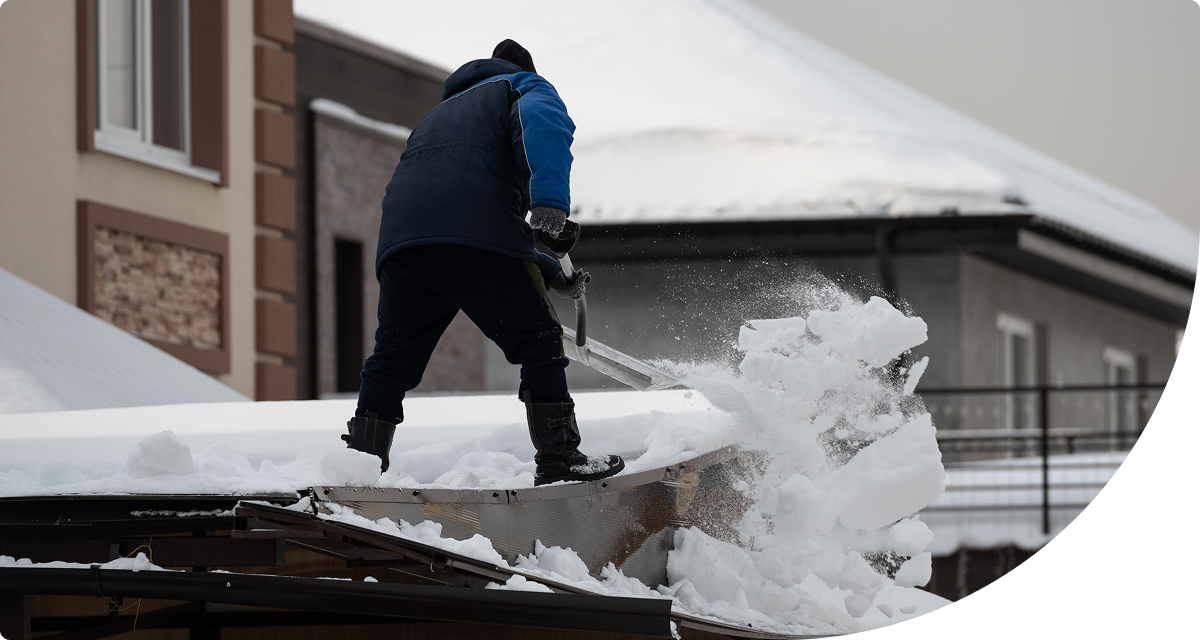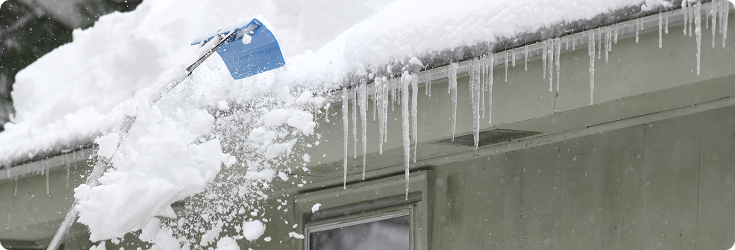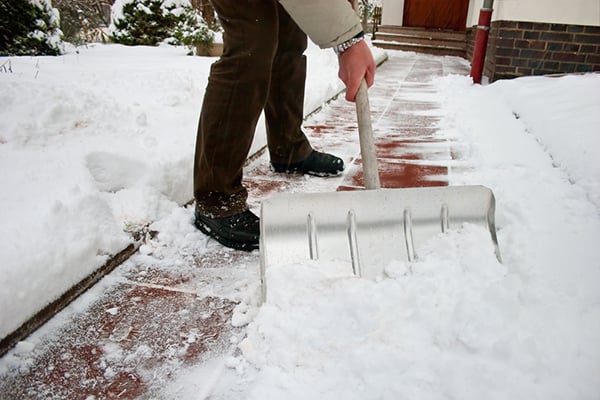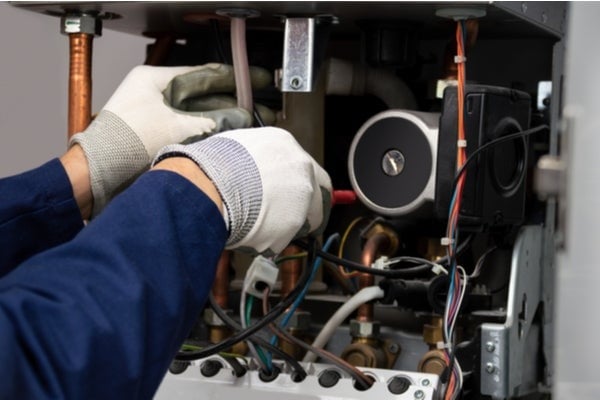How to Protect Your Home From Snow Damage
Snow and ice can take a toll on your home’s roof, gutters, and foundation. Learn how to prepare, prevent damage, and handle buildup before winter weather causes costly repairs.

Key takeaways
- A house with heavy snow on the roof for an extended period of time can experience strained structure, ice dams, and even water leaks inside the home.
- Regular maintenance—like sealing gaps, cleaning gutters, and improving attic insulation—helps prevent snow-related damage.
- If snow buildup causes sagging, leaks, or ice dams, it’s safest to call a Pro instead of attempting snow on roof removal yourself.
There’s nothing like the first winter snowfall. But this magical event is also a reminder of the real risks snow accumulation poses for homeowners. Over 60% of homeowners have experienced winter-related damage, mostly in the form of air leaks, frozen pipes, and HVAC breakdowns.1
The good news? A little preparation can go a long way. This guide will explore how to protect your home from snow, from prevention tips to how to clear snow from your roof once it’s there to knowing when it’s time to call in a Pro. With a few smart steps, you can keep your home comfortable, safe, and ready for the snowy season.
What damage can snow cause?
A house with snow on the roof is a peaceful image right out of a storybook. But the reality is that that same layer of snow can quietly cause big problems. Heavy accumulation adds stress to your home’s structure and can lead to leaks, cracks, or even collapses if left unchecked.
Here’s some of the damage that can be caused by snow covering your house:
- Structural strain: Snow covering your house adds weight that can stress your roof framing or cause ceilings to sag, especially on flat or low-pitched roofs.
- Ice dams: Escaping attic heat melts roof snow, which refreezes near the edges and traps water, forcing it back under shingles and into your home. The result: leaks, stains, and damage inside your attic or ceiling.
- Water intrusion: Melting snow can seep into cracks or weak seals, leading to hidden rot, mold, or foundation damage once temperatures rise.
- Surface damage and safety hazards: Refreezing snow creates slick patches on driveways and steps, while repeated freeze-thaw cycles cause concrete and asphalt to crack.
How do I prepare my house for winter weather?
It’s important to prepare your home to face the elements before the first snow hits. It’s not something you want to scramble to do once the flurries start falling. Here’s how to winterproof your home inside and out.
Protect pipes
Frozen pipes are one of winter’s most common and expensive issues. Wrap exposed pipes in insulation sleeves or heat tape, especially in unheated areas like garages or crawl spaces. Let faucets drip during extreme cold to keep water moving and reduce freeze risk. Don’t forget outdoor spigots and hose bibs—disconnect garden hoses, shut off exterior valves, and insulate faucets.
Seal and insulate
Check for drafts around windows, doors, and attic hatches. Sealing leaks with weatherstripping or caulk helps keep warm air in and cold air out—saving energy and preventing icy spots where condensation can form.
Clean gutters
Clogged gutters can trap melting snow and cause water to back up under shingles. Clean out leaves and debris before the season starts, and make sure downspouts direct water at least a few feet away from your foundation.
Improve attic insulation
A well-insulated attic helps maintain even roof temperatures, reducing the chance of ice dams. Insulation also keeps heat inside, lowering energy bills while helping protect your roof from the effects of heavy snow covering your house.
Inspect your roof
Inspect your roof for loose shingles, flashing gaps, or worn sealant. Addressing small repairs before winter prevents leaks and structural stress once snow starts to accumulate.
Add ice and snow shield
Consider installing an ice and snow shield beneath shingles near the roof edge or valleys. This waterproof barrier adds an extra layer of protection against melting snow seeping into your home.
Check your heating system and chimney
Schedule an HVAC tune-up to make sure your furnace is running efficiently and safely, and replace your furnace filter to improve airflow and energy efficiency. If you have a fireplace, have your chimney inspected and cleaned to prevent blockages and ensure proper ventilation.
Stock up on tools and supplies
Keep winter tools handy: a sturdy roof rake for removal of snow on your roof, shovels or a snow blower for clearing walkways, and pet-safe de-icers for icy steps. Don’t forget warm gloves and safety gear to make outdoor work safer.

When should I be worried about snow on the roof?
A little snow isn’t usually a problem, but too much weight can create serious risks. Most roofs can safely handle around 20 pounds of snow per square foot.2 The trouble starts when storms stack up before the last one has a chance to melt.
Watch for these warning signs that your roof may be under stress:
- Doors or windows suddenly stick or jam.
- Cracks appear in drywall or ceiling plaster.
- You hear creaking or popping noises after heavy snowfall.
- You notice uneven or sagging areas in your roofline.
If you’re unsure, check your attic for leaks or damp insulation, and take photos of any visible sagging. These are clear indicators it’s time to safely remove buildup or call a Pro for inspection. When in doubt, play it safe—removal of snow on your roof is always easier than repairing water damage later.

How to remove snow and ice from your home
Clearing snow in layers rather than all at once reduces strain on your body and your home. Focus first on the areas where ice and buildup can cause the most harm.
Walkways, driveways, and entrances
Clear snow in small layers to prevent ice from forming underneath. Apply pet-safe de-icer to steps and paths, and add traction with sand or cat litter. These steps help protect both you and your home’s surfaces during freezing conditions.
How to clear snow from a roof
Use a roof rake with an extendable handle to pull snow down in thin layers while standing safely on the ground. Work evenly from the edges upward. Never chip at ice or use metal tools that can damage shingles.
- Sloped roofs: Clear lower edges first to allow melting snow to drain freely.
- Flat roofs: Push snow toward drainage points with a plastic shovel or broom, avoiding heavy piles that can strain the structure.
Dealing with ice dams
If ice dams have already formed, use a roof rake or specialized de-icer tools to melt ice along the edges and gutters. Avoid breaking ice manually as it can damage your roof. Placing calcium chloride socks along the ice ridge can safely melt it over time and restore drainage.
When to call a Pro
Some snow jobs are best left to the Pros. If your roof is steep, covered in ice, or shows signs of sagging, it’s safer—and often cheaper long term—to bring in a professional.
You should call a Pro when:
- Snow piles are too deep to clear safely from the ground.
- You spot ice dams or icicles forming along your gutters.
- Water leaks appear inside your attic or ceiling.
- You hear unusual creaks or notice your roofline bending.
Roofing and insulation Pros have the right safety gear and tools to handle the heavy snow covering your house without causing further damage.
Ongoing maintenance
Preventing snow damage is an ongoing habit that helps your home weather each winter more safely.
Here’s how to winterproof your home by performing regular maintenance and checks:
- Regular inspection: Check the exterior of your home—your roof, attic, and gutters—at least twice a year, once before the first freeze and again after the thaw. Look for loose shingles, damp insulation, or blocked vents that could signal hidden damage.
- Clear snow from drainage areas: After every storm, make sure downspouts, sump pump drains, and exterior vents stay open. Keeping these areas clear helps water flow away from your home instead of pooling where it can refreeze or leak inside.
- Plan ahead: Stock up on salt, pet-safe de-icer, and essential tools early. Staying ready means you’ll know exactly how to protect your home from snow when the next storm arrives.
Stay ready for whatever winter brings
Snow is beautiful, but it can also test every part of your home. But with a little preparation and ongoing care, you can protect your roof, pipes, and walkways from the worst of winter’s wear and tear. And when things don’t go according to plan, you don’t have to face it alone.
With American Home Shield®, you get comprehensive coverage for major home systems and appliances, plus access to virtual repair Experts for over-the-phone troubleshooting with select plans.* Members can even add roof leak repair coverage to their home warranty plans for extra protection against unexpected winter damage. It’s peace of mind that helps you focus on enjoying your home instead of worrying about it.
Check out our Home Matters blog for even more winter weather resources, including our winter weather safety checklist.
Sources:
1 https://www.hippo.com/blog/winter-home-damage-survey
2 https://ibhs.org/wp-content/uploads/member_docs/Commercial-Risk-Engineering-Bulletin_Winter-Weather_IBHS.pdf
*Video chat available as a member benefit with select AHS plans. Video chat hours are from 8AM - 9PM CST, 7 days/week. Subject to change.
AHS assumes no responsibility, and specifically disclaims all liability, for your use of any and all information contained herein.
Frequently Asked Questions
Homeowners insurance usually covers sudden or accidental damage from snow, such as a roof collapse caused by heavy accumulation. AHS helps cover the normal wear-and-tear issues, but always check your plan agreement for coverage specifics.
In many cases, yes—if the ice dam causes interior water damage, your homeowners insurance may help pay for repairs. But coverage for the source of the problem (like roof or gutter repairs) often depends on your specific policy. Routine maintenance, such as cleaning gutters and adding insulation, can help prevent ice dams before they start.
Yes. Snow guards—or snow stops—help prevent large sheets of snow and ice from sliding off steep roofs all at once. They’re especially helpful for metal or smooth-surfaced roofs, where snow tends to release suddenly. Snow guards work best as part of a complete winter prep plan that includes insulation, ventilation, and regular snow removal.


